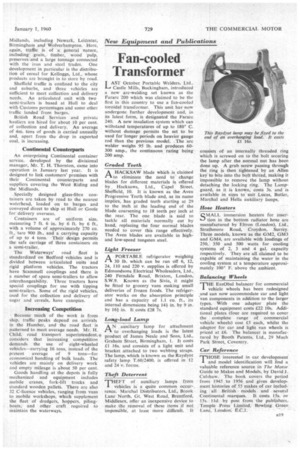Road Fleets Back Waterways Development
Page 50

Page 53

If you've noticed an error in this article please click here to report it so we can fix it.
By G. Duncan Jewel
THE development of Britain's major canals, during the past five years, by the Waterways Division of the British Transport Commission has been helped in no small degree by the solid backing of road transport. Over this build-up period the country's A class waterways have been welded into a unified system capable of taking a place alongside British Road Services and British Railways in providing a national transport network.
Close examination of operations in the Waterways' North Eastern Division, which has its headquarters in Leeds, illustrates how the competitive impact of the division is intensified by the operation of a road transport fleet as an integral part of the Waterways system.
In this division three main waterways are used. They are the Aire and Calder Navigation, from the Humber to waterheads in Leeds and Wakefield; the Sheffield and South Yorkshire, with terminals at Doncaster, Rotherham and Sheffield, and the Trent Navigation, continuation of the Humber Conservancy to Gainsborough, Linea I n, Newark, Nottingham and Leicester.
The bulk of wafer-borne traffic in the division is imported goods from ships docking at Hull and Goole. It is dealt with by a barge fleet of approximately 60 vessels of up to 250 tons carrying capacity, and 'a smaller number of dumb barges. These are supplemented by independent carriers who deal with up to half the traffic.
There is also a compartment-boat fleet. Each vessel—known locally as a "Tom Pudding "—has nearly 700 compartments, with a rated capacity, of 35-40 tons. These small rectangular steel boats 20 ft. long, 15 ft. in beam, and with a moulded depth of 8 ft., are used mainly to carry coal from the Yorkshire collieries to Goole.
They are towed by special tugs in
" trains " of 19 and are so joined that there is sufficient flexibility for the 400ft.-long train to negotiate curves. At
destination each compartment is uncoupled, floated on to a cradle, raised by hoist and tipped.
A further use for these trains is illustrated by the recent speedy shipment of 500 tons of wire from the Humber to Leeds. Reaching Goole at 8 a.m., it was loaded by 2.45 p.m. and arrived in Leeds the following day, a schedule which compares favourably with the time required to dock and load vehicles for delivery by road.
A large volume of oil traffic is also carried by barge from Saltend, in the estuary of the Humber, to storage on the waterways at Nottingham, Doncaster and Leeds.
Fleet Based at Leeds
The Waterways road fleet of 19 vehicles and trailers, based at Leeds, operates throughout the West Riding with occasional journeys to Lancashire. Traffic is varied and includes grain, timber, plywood, veneers, jute, steel, newsprint, wool, sand and sulphur.
Storage and distribution is one of the major services offered. For example, sugar is warehoused at the new Knostrop Depot, Leeds, for Tate and Lyle, Ltd., and delivered throughout the West Riding by Waterways vehicles. The sugar is mainly delivered from Liverpool by outside road transport, but occasional 30-40-ton loads arrive by barge. Warehouse capacity in the North Eastern area is some 30,000 tons.
At Nottingham there are 16 vehicles Which serve the (Continued on page 729)
Midlands, including Newark, LeiCester, Birmingham and Wolverhampton. • Here, again, traffic is of a_ general nature, including' grain, timber, wood pulp, preserves and a large tonnage connected with the iron and steel trades. One development in particular is the distribution of cereal for Kellogg,s, Ltd., whose products are brought in to store by road.
Sheffield traffic is confined to the city and suburbs, and three vehicles are sufficient to meet collection and delivery needs. An articulated unit with two semi-trailers is based at Hull to deal with Customs percentages and some other traffic landed from barges.
British Road Services and private hauliers are hired for about 10 per cent. of collection and delivery. An average of 4m. tons of goods is carried • annually and, apart from the drop in exported coal, is increasing.
Continental Counterparts
An enterprising Continental container service, developed by the divisional manager, Mr. T. H. Thornton, came into operation in January last year. It is designed to link customers' premises with their Continental counterparts and suppliers covering the West Riding and the Midlands.
Specially designed glass-fibre containers are taken by road to the nearest waterhead, loaded on to barges and conveyed direct to ship at Hull or Goole for delivery overseas.
Containers are of uniform size, measuring 7 ft. 6 in. by 6 ft. by 6 ft., with a volume of approximately 270 cu. ft., tare 900 lb., and a carrying capacity of up to 4 tons. Their design permits the safe carriage of three containers on
serni-rtrailer.
The Waterways' road fleet is standardized on Bedford vehicles and is divided between articulated units and rigid platform vehicles. The tractors have Scammell couplings and there is a number of spare semi-trailers to allow interchangeability. Three tractors have special couplings for use with tipping semi-trailers. Some of the rigid vehicles, used for the collection and delivery of sugar and cereals, have canopies.
Increasing Competition Because much of the work is from ship, traffic peaks depend on arrivals in the Humber, and the road fleet is patterned to meet average needs. Mr. H. Child, road transport. superintendent,. considers that increasing• competition demands the use of eight-wheeled vehicles—carrying 16 tons, instead of the present average of 9 tons—for economical handling of bulk loads. The vehicles are mainly on delivery work and empty mileage is about 50 per cent.
Goods handling at the depots is fully mechanized and equipment includes mobile cranes, fork-lift trucks and standard wooden pallets. There are also 32 C-licence vehicles, ranging from vans to mobile workshops, which supplement the fleet of dredgers, hoppers, pilingboats, and other craft required to rnairitain the waterways.




























































































